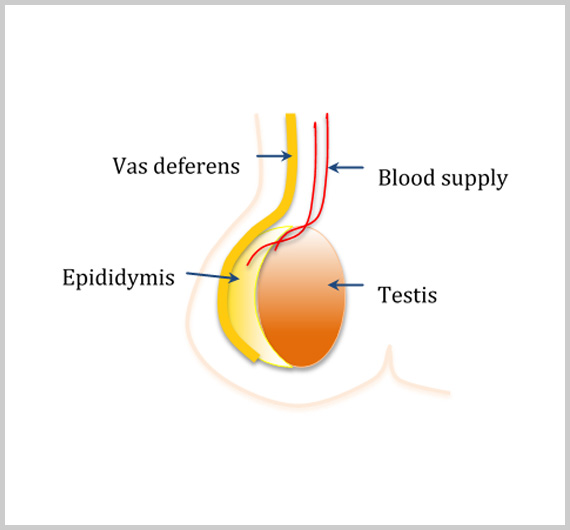What are the testicles?
The testicle is the male gonad and are components of both the reproductive system and the endocrine system. The primary functions of the testes are to produce sperm (spermatogenesis) and to produce androgens, primarily testosterone.
The testes are contained within an extension of the abdomen called the scrotum. It is common for one testicle to hang lower (~80% of men finding the right hangs lower). Normal testicle size ranges from 12 cm³ to 30 cm³ and its not uncommon for a man to notice differences in size between his two.
The testis contains very fine coiled tubes called seminiferous tubules. The tubules are lined with a layer of cells (germ cells) that from puberty into old age, develop into sperm cells (also known as spermatozoa). The developing sperm travel through the seminiferous tubules to the epididymis where newly created sperm cells mature. The sperm move into the vas deferens, and are eventually expelled through the urethra and out of the urethral orifice through muscular contractions. In addition, between tubules are Leydig cells that produce and secrete testosterone and other androgens important for sexual development and puberty, secondary sexual characteristics like facial hair, sexual behaviour and libido.
Many anatomical features of the adult testis reflect its developmental origin in the abdomen. The layers of tissue enclosing each testicle are derived from the layers of the anterior abdominal wall. Notably, the cremasteric muscle arises from the internal oblique muscle.

What is testicular cancer?
Testicular cancer is the second most common cancer in young men aged 18 to 39 with just under 800 cases diagnosed each year in Australia.
Testicular cancer is classified into two main types: Germ cell tumours and non-germ cell tumours.
Germ cells tumours are the most common type. There are further classified into Seminoma and non-seminona tumours. Seminoma is most common in men aged between 25 and 50 years while non-seminoma is more common in younger men, usually in their 20s.
Men over 80yo can get cancer in the testis but it is more likely to be lymphoma.
Testicular cancer symptoms
Testicular cancer may cause no symptoms.
The most common symptoms are:
- Painless swelling or a lump in a testicle.
- Enlargement of a testicle
- Feeling of heaviness in the scrotum
- Change in the size or shape of the testicle
- A dull ache in the lower abdomen, the testicle or scrotum
- Fluid collection in the scrotum
- Enlargement or tenderness of the breast tissue (due to hormones created by cancer cells)
Causes of testicular cancer
The causes of testicular cancer are unknown, however factors that may increase a man’s risk are:
- Undescended testicle (when an infant)
- Family history (having a father or brother who has had testicular cancer).
There is no known link between testicular cancer and injury to the testicles, sporting strains, hot baths or wearing tight clothes.
Diagnosis for testicular cancer
Once physical examination has aroused suspicious of a cancer the next steps are:
- Ultrasound (to confirm the presence of a mass)
- Blood tests for the tumour markers
- lactate dehydrogenase (LDH)
- beta human chorionic gonadotrophin (BhCG)
- alpha-fetoprotein (AFP).
- CT scan of chest, abdomen and pelvis (to determine whether and how far the cancer has spread)
Staging for testicular cancer
Combining the findings from the CT scan, blood test and histopathological findings of the testicle, stage of the cancer is determined. Testicular cancer can be classified in a TNM classification but is frequently describes as stages.
Stages of testicular cancer
| Stage | Classification |
| 1 | Cancer confined to testis |
| 2 | Cancer spread to regional lymph nodes |
| 3 | Cancer spread beyond lymph nodes to other areas (liver, lung) |
Testicular cancer TNM classification
| TNM | Classification | Features |
| T | 1 | Tumour confined to testis without vascular or lymphatic invasion |
| 2 | Tumour confined to testis but with invasion into vessels, lymphatic or tunica vaginalis | |
| 3 | Tumour invades into spermatic cord | |
| 4 | Tumour extends into scrotum | |
| N | 1 | Tumour in regional lymph nodes <2cm in size |
| 2 | Tumour in regional lymph nodes 2-5cm in size | |
| 3 | Tumour in regional lymph nodes >5cm | |
| M | 1a | Non-regional lymph nodes or lung involved |
| 1b | Other sites involved (brain, liver etc) | |
| S | 1 | LDH <1.5 x N* BhCG <5,000 AFP <1,000 |
| 2 | LDH 1.5-10 x N BhCG 5,000 -50,000 AFP 1,000-10,000 | |
| 3 | LDH >10 x N BhCG >50,000 AFP >10,000 |
*Normal
Treatment
If the cancer is found only in the testicle, removal of the testicle (orchidectomy) may be the only treatment needed. If the cancer has spread beyond the testicle, chemotherapy and/or radiotherapy may be used as well.
KEY POINTS
- Testicular cancer is the second most common cancer in young men.
- Testicular cancer usually presents as a lump in the testis.
- An orchiectomy (surgical excision of the testicle) is required for accurate diagnosis and if done early enough, may be the only treatment required.
- Once spread outside the scrotum additional therapy is required (chemotherapy or radiotherapy)
- The cure rate for testicular cancer is high, with rates higher the earlier treatment is started
